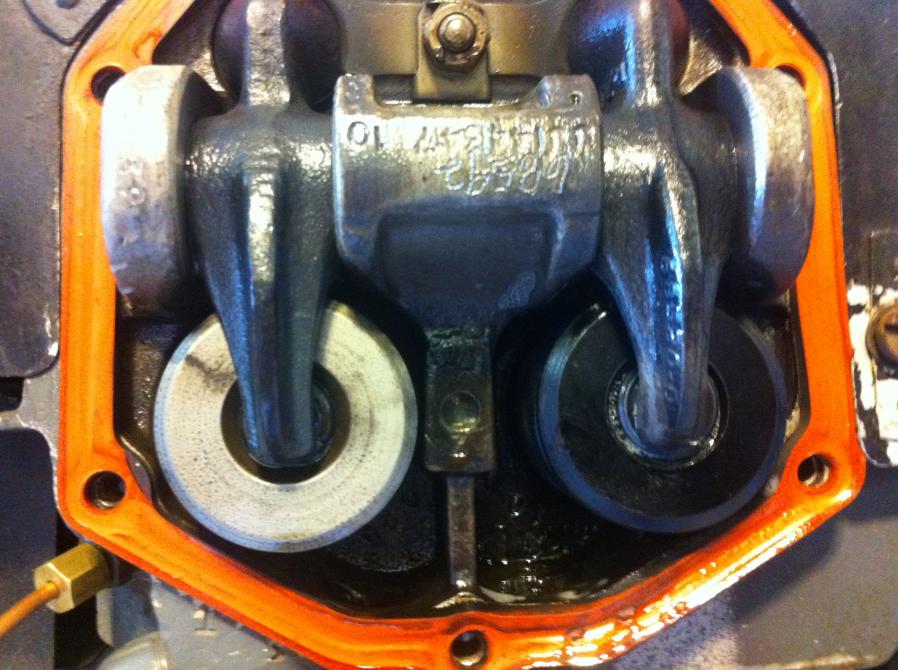check it for air leaks
check it for air leaks
I will - I'm going to be all over it when it goes back together. Anything in the intake tract that could cause unequal fuel distribution?
A Lyco engine has a central intake plenum integrated with the oil sump. All of the intake risers are close in length and the design results in relatively even fuel air distribution to the cylinders. So I agree with the poster who said check all of your intake gaskets and rubber parts.
If you have a leaking exhaust valve you are likely into replacing a valve guide. That is a common repair and if the rest of the cylinder looks OK, there is no reason do do more than than. You can reuse the piston and rings so long as you do not hone the bore. Clean up the valve and reinstall after re-cutting the valve seat. Relatively inexpensive repair to do.
Best of luck,
Wes
I pulled the valve cover from #3 and it's clear that heat is being carried into the exhaust spring. I imagine that it's on it's way to being sacked. I'm still trying to get my head around why the cylinder with the lowest compression is the one with leanest looking plug. One would think that the plug would look fouled from incomplete or poor burning.
Is there a way to get the cylinders (narrow deck) off without buying the specialty wrenches? It's not that I mind buying the wrenches, but rather that I've got a borrowed trailer and want to minimize the amount of time that I need to hang on to it. Once the cylinders are off I plan to haul my fuselage back to the airport from my shop. Ordering wrenches will probably slow things down a by few days.

I found some other articles of interest at http://www.avweb.com/news/savvyaviat..._197497-1.html and http://www.tcmlink.com/pdf2/SB03-3.pdf.
First of all, I'm not an A & P but I'm a journeyman diesel mechanic with over 40 years of experience working with all kinds of engines, most a lot more complicated than your typical aircraft engine. Having said that, I've had good luck on some engines pulling both plugs and shining a 'bend a light' into the cylinder from the bottom plug hole. It's possible (in some cases) to examine most of the valve face and seat with the cam on the high side and the valve open. One other thought: I used to own a Cherokee 140 with a 150 Lycoming and took it in for an annual. The engine had less than 500 hours since major. For some reason, I had a couple of cylinders that were about 60/80 according to his leakage tester and appeared to be blowby. He sort of insisted that the cylinders needed to come off for repair but I insisted that we run a cranking compression test. The compressions were all even at around 130 psi if I remember correctly. At that point he signed it off. That was probably 20 years ago and that engine is still running with the same cylinders as far as I know (and passing annuals). Point is: don't be too quick to jerk the cylinder, run it for awhile and recheck. Remember the piston is only in the TDC position of a millisecond when the engine is running and you have a lot more pressure (than 80 psi) behind the rings to seal to the cylinder with the 'firing pressures' of combustion .Obviously, if the exhaust or intake valves have a constant leak or oil consumption is a problem that's a different story but I've seen a lot of cylinders pulled when things should have been checked out further. Just my .02 cents.....
If God had intended man to fly He would have given us more money!
With even a little air in the cylinders there is a lot of leakage through the exhaust valves. I don't see any indication that they are burning though. I'm guessing the guides are lose. But it's easy enough to pull things and take a look. In fact all I need is for those specialty base nut wrenches to arrive and I'm good to go.
If the guides are not loose - might you be a victim of debris from the top plug being removed first before a compression test? This was first suggested by John Thorpe. You have to run the engine for a couple of hrs to hammer it out of there, & then recheck compression via the bottom plugs.
Anybody else heard of this?
I was thinking of your comment wondering why the lowest compression cylinder might be lean? Can you put a dial indicator on the rocker and check the lift of the intake /exhaust valves? perhaps the can lobe/s is/are worn? Although with your comment on the guides also make me wonder if #1 and #3 could be affecting one another during the valve overlap, do you have the cross-over exhaust or the regular style?
Last edited by Racegunz; 07-28-2012 at 06:41 AM.
Before you pull the cylinder, do the rope trick, and check the guides you may simply be able to ream the guides back to standard, and be done. the carbon deposits may be holding the valve open.